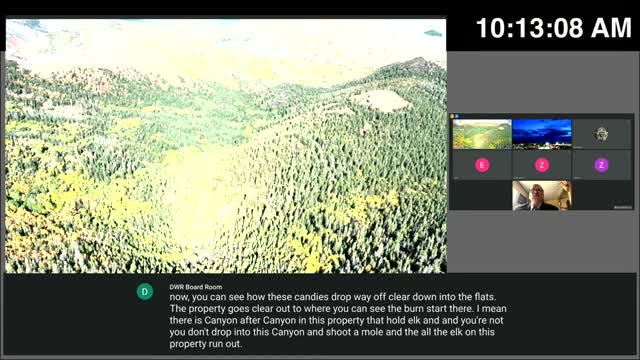Elk Habitat Crisis Sparks Urgent Call for Conservation Action
August 22, 2024 | Wildlife Resources, Utah Environment, State Agencies, Organizations, Utah Executive Branch, Utah
This article was created by AI summarizing key points discussed. AI makes mistakes, so for full details and context, please refer to the video of the full meeting. Please report any errors so we can fix them. Report an error »

In a recent government meeting, discussions centered around the management and conservation of elk habitats in the wake of a significant wildfire that affected 18,000 acres of land. The fire, which closed access roads and devastated vegetation, has heightened concerns about the future of elk populations in the region. A representative highlighted the unique qualities of their property, which serves as a crucial refuge for elk, particularly due to its abundant water sources and protective cover.
The elk management plan presented during the meeting emphasized the importance of private land partnerships in preserving vital habitats. The representative argued that the property in question is ideally situated to support elk, noting that studies indicate elk typically do not venture more than half a mile from water sources. With 80% of the water in the area located on their land, the potential for successful elk management is significant.
Despite the challenges posed by the wildfire and previous pushback from stakeholders, the representative expressed a strong commitment to collaborating with the Department of Wildlife Resources (DWR) to ensure the land remains a sanctuary for wildlife rather than being developed into residential areas. They underscored the urgency of the situation, warning that without effective partnerships, the land could be lost to development, which would threaten the region's elk population.
The meeting also revealed a divided opinion among regional advisory councils regarding the proposed management strategies, with some supporting the initiative while others opposed it. The representative called for further discussions, emphasizing the need for expert insights from biologists familiar with the area to guide decision-making.
Overall, the meeting underscored the critical intersection of wildlife conservation, land management, and community interests, as stakeholders navigate the complexities of preserving elk habitats in a changing landscape.
The elk management plan presented during the meeting emphasized the importance of private land partnerships in preserving vital habitats. The representative argued that the property in question is ideally situated to support elk, noting that studies indicate elk typically do not venture more than half a mile from water sources. With 80% of the water in the area located on their land, the potential for successful elk management is significant.
Despite the challenges posed by the wildfire and previous pushback from stakeholders, the representative expressed a strong commitment to collaborating with the Department of Wildlife Resources (DWR) to ensure the land remains a sanctuary for wildlife rather than being developed into residential areas. They underscored the urgency of the situation, warning that without effective partnerships, the land could be lost to development, which would threaten the region's elk population.
The meeting also revealed a divided opinion among regional advisory councils regarding the proposed management strategies, with some supporting the initiative while others opposed it. The representative called for further discussions, emphasizing the need for expert insights from biologists familiar with the area to guide decision-making.
Overall, the meeting underscored the critical intersection of wildlife conservation, land management, and community interests, as stakeholders navigate the complexities of preserving elk habitats in a changing landscape.
View full meeting
This article is based on a recent meeting—watch the full video and explore the complete transcript for deeper insights into the discussion.
View full meeting

